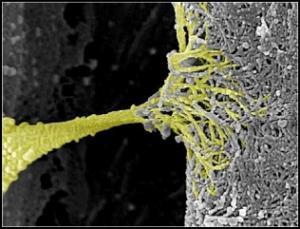Reparative and Regenerative Therapeutics
 Regenerative medicine aims at achieving tissue regeneration and restoration of organ function by harnessing and enhancing the endogenous repair mechanisms, either by implanting cell preparations within damaged tissues or, more recently, by stimulating the repair capacity of resident stem cells without ex vivo manipulations by interfering with specific molecular signals. Several CiTI team leaders are currently performing research focused on discovering new reparative and regenerative therapies and, indeed, this theme is intertwined with Target Identification and Therapeutic Innovation, as the desired end point of these new therapeutic strategies is to correct and repair ongoing chronic pathologies characterized by tissue damage.
Regenerative medicine aims at achieving tissue regeneration and restoration of organ function by harnessing and enhancing the endogenous repair mechanisms, either by implanting cell preparations within damaged tissues or, more recently, by stimulating the repair capacity of resident stem cells without ex vivo manipulations by interfering with specific molecular signals. Several CiTI team leaders are currently performing research focused on discovering new reparative and regenerative therapies and, indeed, this theme is intertwined with Target Identification and Therapeutic Innovation, as the desired end point of these new therapeutic strategies is to correct and repair ongoing chronic pathologies characterized by tissue damage.
Professor Dell’Accio and his group investigate the molecular mechanisms that preside to the healing of skeletal tissues, and in particular to cartilage, with the ultimate aim of identifying possible therapeutic intervention to promote cartilage healing/supporting cartilage homeostasis in diseases such as isolated cartilage defects and osteoarthritis. Professor Dell’Accio’s group identified a distinct signalling response of adult human articular cartilage to mechanical injury. Individual molecules and signalling pathways, including WNTs, CaMKII, CXCR2 signalling and Agrin-LRP4 signaling identified by this screening are being tested in vitro and in vivo for their function in cartilage biology and joint surface repair.
Prof Dell’Accio is also a partner at the Arthritis Research UK Centre for OA Pathogenesis led by the University of Oxford. The research goals of this Centre are to uncover the pathways in which cartilage tissue is made and maintained throughout life. Moreover, Prof Dell’Accio and Prof Perretti are working on cell-derived vesicles as new reparative and regenerative therapies, also in association with the supporting partner UCB Pharma.
Dr Dalli and Dr Norling are defining the tissue reparative and regenerative properties of novel lipid mediators with a focus on chondrocyte and cartilage but also gut and lung epithelia.
Prof Marino’s group studies the epigenetic mechanisms regulating the biology of normal and neoplastic stem cells. Her studies led to the discovery of the role of BMI1 in proliferation control of neural progenitors and self-renewal/maintenance of postnatal neural stem cells (Jacobs et al. Nature 1999, Leung et al. Nature 2004, Bruggeman et al. G&D 2005). In this context, the laboratory has shown that BMI1 is a downstream target of the SHH signalling pathway and that it plays a key role in linking the pathway to the cell cycle machinery through transcriptional repression of the ink4a/arf locus and p21cip1/waf1 (Bruggeman et al. G&D 2005, Subkhankulova et al. MCN 2010). Conditional overexpression of BMI1 in neural stem cells increases the stem cell pool through histone-mediated regulation of transcription at key target genes (Yadirgi et al. Stem Cells 2011, Acquati et al. Stem Cells 2013).The Marino laboratory has shown for the first time that upregulation of the expression of BMI1 in the main skeletal muscle stem cell population, the satellite cells, enhances its regenerative capacity in mouse models of Duchenne Muscular Dystrophy, leading to improvement of muscle strength. Moreover, the group has demonstrated that this effect is achieved mechanistically by a functional cooperation between BMI1 and MT1 (Metallothionein 1) which protects stem cells, triggered to re-enter the cell cycle in the context of the regenerative process, against oxidative stress-induced cellular damage (Robson et al PLOS One 2011 and Di Foggia et al J. Exp. Med 2014).
The Marino lab has a long-standing record of accomplishment in the successful application of basic scientific knowledge gained from basic studies of lack of function and gain of function mouse models into improving our understanding of human diseases (Leung et al. Nature 2004, Shakhova et al. Cancer Research 2006, Sutter et al. Oncogene 2010 and Merve et al. ANC 2014). Her team is particularly interested in assessing how fine tuning the expression of the Polycomb group of genes can be exploited to enhance the regenerative function of stem cells in ageing and disease.


